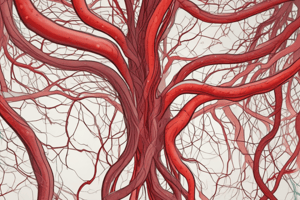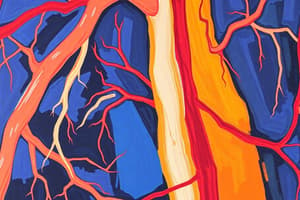Podcast
Questions and Answers
Match the type of blood vessel with its primary characteristic:
Match the type of blood vessel with its primary characteristic:
Arteries = Have thick, muscular walls Veins = Contain valves to prevent backflow Capillaries = Allow for efficient exchange of gases and nutrients
Match the type of artery with its description:
Match the type of artery with its description:
Elastic arteries = Can stretch and recoil Muscular arteries = Control blood flow to organs Superficial veins = Located close to the skin surface Deep veins = Accompany arteries deeper in the body
Match the blood flow regulation method with its action:
Match the blood flow regulation method with its action:
Vasoconstriction = Narrowing of the artery Vasodilation = Widening of the artery Valves in veins = Prevent backflow of blood Skeletal muscle contraction = Assists in regulating blood flow
Match the type of blood vessel with its function:
Match the type of blood vessel with its function:
Match the disease with the type of blood vessel it typically affects:
Match the disease with the type of blood vessel it typically affects:
Match the aspect of blood vessels with its consequence:
Match the aspect of blood vessels with its consequence:
Match the blood vessel type with its pressure state:
Match the blood vessel type with its pressure state:
Match the blood vessel type with its structure:
Match the blood vessel type with its structure:
Match the type of capillary network to its description:
Match the type of capillary network to its description:
What type of blood vessels carry oxygen-rich blood away from the heart?
What type of blood vessels carry oxygen-rich blood away from the heart?
Which of the following structures is responsible for allowing nutrient exchange?
Which of the following structures is responsible for allowing nutrient exchange?
What is the main function of the lungs in the circulatory system?
What is the main function of the lungs in the circulatory system?
What is a characteristic feature of veins?
What is a characteristic feature of veins?
Which major veins return deoxygenated blood to the heart?
Which major veins return deoxygenated blood to the heart?
What regulates the heartbeat through electrical impulses?
What regulates the heartbeat through electrical impulses?
What type of circulation involves the flow of blood to and from the lungs?
What type of circulation involves the flow of blood to and from the lungs?
Which major artery distributes oxygenated blood from the heart?
Which major artery distributes oxygenated blood from the heart?
What feature of arteries allows them to withstand high pressure from blood flow?
What feature of arteries allows them to withstand high pressure from blood flow?
What do internal carotid and vertebral arteries primarily supply?
What do internal carotid and vertebral arteries primarily supply?
Flashcards are hidden until you start studying
Study Notes
Blood Vessels Overview
- Blood vessels are the conduits for blood flow throughout the body.
- There are three main types of blood vessels: arteries, veins, and capillaries.
Arteries
- Carry oxygenated blood away from the heart (except pulmonary arteries).
- Have thick, muscular walls to withstand high pressure.
- Can be divided into:
- Elastic arteries: Large vessels (e.g., aorta) that can stretch and recoil.
- Muscular arteries: Medium-sized, control blood flow to organs through vasoconstriction and vasodilation.
Veins
- Carry deoxygenated blood back to the heart (except pulmonary veins).
- Have thinner walls and larger lumens compared to arteries.
- Contain valves to prevent backflow of blood.
- Can be categorized into:
- Superficial veins: Located close to the skin surface.
- Deep veins: Located deeper in the body, often accompanying arteries.
Capillaries
- Microscopic vessels that connect arteries and veins.
- Walls are only one cell thick, allowing for efficient gas, nutrient, and waste exchange.
- Form extensive networks (capillary beds) in tissues.
Blood Flow Regulation
- Arteries control blood flow via:
- Vasoconstriction: Narrowing of the artery, increasing blood pressure.
- Vasodilation: Widening of the artery, decreasing blood pressure.
- Veins assist in regulating blood flow through the use of valves and skeletal muscle contraction.
Key Differences Between Arteries and Veins
- Structure: Arteries have thicker walls and more elastic fibers; veins have thinner walls and valves.
- Function: Arteries transport blood away from the heart; veins transport blood to the heart.
- Pressure: Arterial blood is under higher pressure; venous blood is under lower pressure.
Additional Notes
- Blood vessels can be affected by diseases such as atherosclerosis (arteries) and varicose veins (veins).
- Health of blood vessels is crucial for overall circulatory system efficiency and blood flow regulation.
Blood Vessels Overview
- Blood vessels are responsible for transporting blood throughout the body.
- There are three main types of blood vessels: arteries, veins, and capillaries.
Arteries
- Arteries carry oxygenated blood away from the heart, with the exception of pulmonary arteries.
- Arteries have thick, muscular walls that enable them to withstand the high pressure of blood being pumped from the heart.
- Arteries can be categorized into two types:
- Elastic arteries are large vessels, such as the aorta, which are capable of stretching and recoiling to accommodate changes in blood flow.
- Muscular arteries are medium-sized vessels that control blood flow to organs through vasoconstriction (narrowing) and vasodilation (widening).
Veins
- Veins carry deoxygenated blood back to the heart, with the exception of pulmonary veins.
- Compared to arteries, veins have thinner walls and larger lumens (internal spaces).
- Veins contain valves to prevent the backflow of blood.
- There are two types of veins:
- Superficial veins are located close to the surface of the skin.
- Deep veins are located deeper within the body, often running alongside arteries.
Capillaries
- Capillaries are microscopic vessels that connect arteries and veins.
- Their walls are only one cell thick, enabling efficient exchange of gases, nutrients, and waste products between the blood and surrounding tissues.
- These capillaries form extensive networks, called capillary beds, within tissues.
Blood Flow Regulation
- Arteries regulate blood flow through vasoconstriction and vasodilation.
- Veins assist in blood flow regulation by utilizing valves and leveraging skeletal muscle contraction.
Key Differences Between Arteries and Veins
- Structure: Arteries have thicker walls with more elastic fibers, while veins have thinner walls and contain valves.
- Function: Arteries carry blood away from the heart, while veins transport blood back to the heart.
- Pressure: Arterial blood is under higher pressure compared to venous blood.
Additional Notes
- Blood vessels can be affected by diseases such as atherosclerosis (narrowing of arteries) and varicose veins (enlarged veins).
- The health of blood vessels is essential for overall circulatory system efficiency and effective blood flow regulation.
Blood Vessels
- Tubular structures transporting blood throughout the body
- Arteries: Carry oxygen-rich blood from the heart (except pulmonary arteries)
- Veins: Carry oxygen-poor blood to the heart (except pulmonary veins)
- Capillaries: Microscopic vessels where gas (oxygen and carbon dioxide) and nutrient exchange occurs
Arteries
- Thick, elastic walls withstand high pressure
- Smooth muscle layer contracts or relaxes to regulate blood flow
- Aorta: Largest artery, distributing oxygenated blood from the heart
- Pulmonary Arteries: Carry deoxygenated blood from the heart to the lungs
Veins
- Thinner walls than arteries, less muscular and elastic
- Contain valves to prevent backflow of blood
- Superior and Inferior Vena Cava: Return deoxygenated blood to the heart
- Pulmonary Veins: Carry oxygenated blood from the lungs to the heart
Blood Flow and Beat
- Heartbeat: Rhythmic contraction of the heart pumping blood through the circulatory system
- Regulated by electrical impulses from the sinoatrial (SA) node
- Circulation:
- Systemic Circulation: Blood flows from the heart to all body parts (except the lungs), delivering oxygen and returning deoxygenated blood
- Pulmonary Circulation: Blood flows from the heart to the lungs and back, allowing for gas exchange
Lungs
- Main organ for gas exchange, blood releases carbon dioxide and absorbs oxygen
- Deoxygenated blood arrives through pulmonary arteries, gets oxygenated in the alveoli, and returns to the heart via pulmonary veins
Brain
- Supplied by internal carotid arteries and vertebral arteries
- Blood-brain barrier protects brain tissue, limiting substance passage
- Continuous blood flow is essential due to high metabolic activity, delivering oxygen and glucose to maintain brain function
Studying That Suits You
Use AI to generate personalized quizzes and flashcards to suit your learning preferences.




